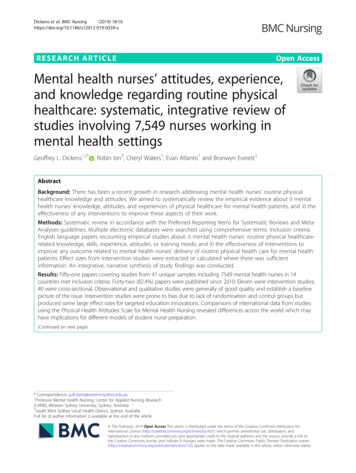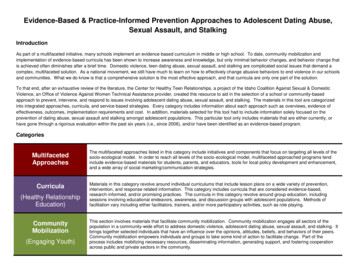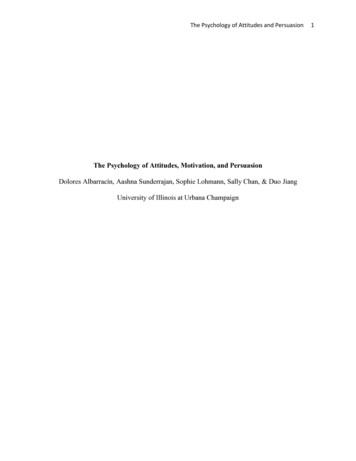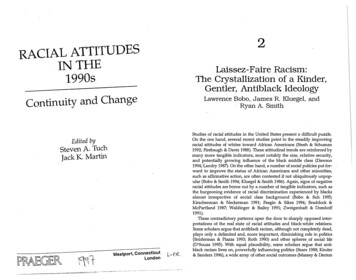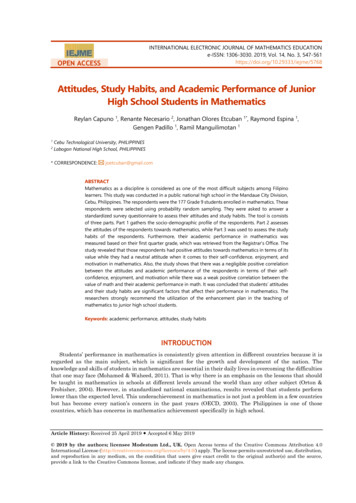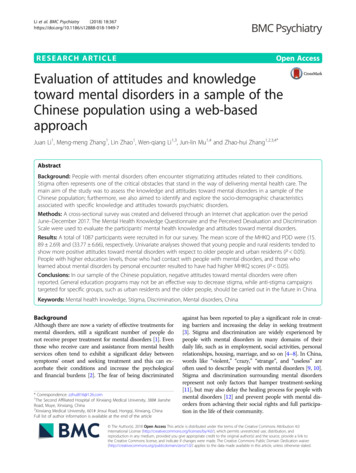
Transcription
Li et al. BMC Psychiatry(2018) EARCH ARTICLEOpen AccessEvaluation of attitudes and knowledgetoward mental disorders in a sample of theChinese population using a web-basedapproachJuan Li1, Meng-meng Zhang1, Lin Zhao1, Wen-qiang Li1,3, Jun-lin Mu1,4 and Zhao-hui Zhang1,2,3,4*AbstractBackground: People with mental disorders often encounter stigmatizing attitudes related to their conditions.Stigma often represents one of the critical obstacles that stand in the way of delivering mental health care. Themain aim of the study was to assess the knowledge and attitudes toward mental disorders in a sample of theChinese population; furthermore, we also aimed to identify and explore the socio-demographic characteristicsassociated with specific knowledge and attitudes towards psychiatric disorders.Methods: A cross-sectional survey was created and delivered through an Internet chat application over the periodJune–December 2017. The Mental Health Knowledge Questionnaire and the Perceived Devaluation and DiscriminationScale were used to evaluate the participants’ mental health knowledge and attitudes toward mental disorders.Results: A total of 1087 participants were recruited in for our survey. The mean score of the MHKQ and PDD were (15.89 2.69) and (33.77 6.66), respectively. Univariate analyses showed that young people and rural residents tended toshow more positive attitudes toward mental disorders with respect to older people and urban residents (P 0.05).People with higher education levels, those who had contact with people with mental disorders, and those wholearned about mental disorders by personal encounter resulted to have had higher MHKQ scores (P 0.05).Conclusions: In our sample of the Chinese population, negative attitudes toward mental disorders were oftenreported. General education programs may not be an effective way to decrease stigma, while anti-stigma campaignstargeted for specific groups, such as urban residents and the older people, should be carried out in the future in China.Keywords: Mental health knowledge, Stigma, Discrimination, Mental disorders, ChinaBackgroundAlthough there are now a variety of effective treatments formental disorders, still a significant number of people donot receive proper treatment for mental disorders [1]. Eventhose who receive care and assistance from mental healthservices often tend to exhibit a significant delay betweensymptoms’ onset and seeking treatment and this can exacerbate their conditions and increase the psychologicaland financial burdens [2]. The fear of being discriminated* Correspondence: zzhui816@126.com1The Second Affiliated Hospital of Xinxiang Medical University, 388# JiansheRoad, Muye, Xinxiang, China2Xinxiang Medical University, 601# Jinsui Road, Hongqi, Xinxiang, ChinaFull list of author information is available at the end of the articleagainst has been reported to play a significant role in creating barriers and increasing the delay in seeking treatment[3]. Stigma and discrimination are widely experienced bypeople with mental disorders in many domains of theirdaily life, such as in employment, social activities, personalrelationships, housing, marriage, and so on [4–8]. In China,words like “violent,” “crazy,” “strange”, and “useless” areoften used to describe people with mental disorders [9, 10].Stigma and discrimination surrounding mental disordersrepresent not only factors that hamper treatment-seeking[11], but may also delay the healing process for people withmental disorders [12] and prevent people with mental disorders from achieving their social rights and full participation in the life of their community. The Author(s). 2018 Open Access This article is distributed under the terms of the Creative Commons Attribution 4.0International License (http://creativecommons.org/licenses/by/4.0/), which permits unrestricted use, distribution, andreproduction in any medium, provided you give appropriate credit to the original author(s) and the source, provide a link tothe Creative Commons license, and indicate if changes were made. The Creative Commons Public Domain Dedication o/1.0/) applies to the data made available in this article, unless otherwise stated.
Li et al. BMC Psychiatry(2018) 18:367Moreover, the family members of people with mental disorders are often blamed by the public [13]. Empirical evidence showed that families of people withmental disorders are likely to ignore the problemwhen their family members experience discrimination:they may hide them from public life, delay treatmentseeking, or even reject professional help. Such attitudes and behaviors may determine a pejorative illness course and increase the psychological andfinancial burdens on the families [14–16].In order to reduce the treatment gap and providemore consistent and accessible mental health services,the World Health Organization (WHO) has encouraged countries to integrate mental health services intotheir primary care systems. However, negative attitudes toward mental disorders among the generalpopulation are likely to represent an obstacle to thedevelopment of more efficient community mentalhealth services [17].Additionally, the general public could, through greatersocial engagement and more acceptance of mental disorders, play an essential role in rehabilitating the mentallyill. This is no easy task, since people with mental disorders have often been labeled as “violent” and “dangerous”, and the attitudes of the general public havecontributed to exacerbating the conditions of peoplewith mental disorders [18].Thornicroft et al. [19] defined stigma as an overarching term that refers to three main elements:problems of knowledge (ignorance), problems of attitude (prejudice), and problems of behavior (discrimination). It has been reported that lack of accuratemental health knowledge may be one of the leadingfactors that may contribute to stereotyping peoplewith mental disorders [20]. However, it has also beenfound that health professionals, who are supposed tohave greater knowledge concerning mental health issues with respect to the general population, oftenhave more negative attitudes toward mental disordersthan the general public [21–23]. This finding contradicts a common assumption that greater knowledgeof mental disorders results in less of a discriminatoryattitude, and thus it throws into question the, supposedly positive, relationship between mental healthknowledge and discriminatory attitudes.The main aims of this study were to evaluate attitudesand knowledge about mental disorders in a sample ofthe Chinese general population and to explore their relationships with socio-demographic characteristics. Resultsfrom this study could yield some applications: first, itcould help in designing programs that would aim to reduce public stigma against mental disorders; second, itcould provide guidance for the government to undertakefurther strategic action.Page 2 of 8MethodsParticipantsA “snowball” sampling method was used to recruit participants. A digital version of a self-made schedule and of twostandardized questionnaires was sent to 50 people known tothe study authors (including families, friends, and other acquaintances), who previously agreed to participate in thestudy and to share the digital questionnaires through theInternet chat application “We-Chat”, which has over 800million active members in China. A standardized statementaccompanying the questionnaire encouraged all the participants to transmit the electronic questionnaire to their friendsor family members. Participants were informed, at the beginning of the survey, that expression “mental disorders” in thequestionnaire referred to schizophrenia, depression, and bipolar disorder. All potential participants were also informedthat they had a chance to win a raffle prize as a reward.Participants were finally asked to provide anonymousinformed consent in electronic format, before takingpart in the survey. The survey was conducted from Juneto December 2017. The study protocol was approved bythe Research Ethics Committee of the Second AffiliatedHospital of Xinxiang Medical University.InstrumentsA self-made questionnaire was used to collect participants’ basic demographic data (including age, gender,level of education, and place of residence).The Mental Health Knowledge Questionnaire (MHKQ)was developed to evaluate public knowledge and awarenessof mental health by the Chinese Ministry of Health (MOH)in 2009. It contains 20 self-administered items. Items 1–16(the first section) require participants to select “true,”“false,” or “unknown” about statements concerning mentalhealth. For items 1, 3, 5, 7, 8, 11, 12, 15 and 16, a “true” answer corresponded to a 1-point score, while a “false” or“unknown” answer corresponded to score of 0. By contrast,for items 2, 4, 6, 9, 10, 13 and 14, a “false” answer gave ascore of 1, while “true” or “unknown” answers corresponded to score of 0. Finally, items 17–20 (the second section) are statements concerning previous knowledge aboutthe “four mental health promotion days”. Total scoresrange from 0 to 20, with higher scores indicating greaterknowledge of mental health issues. The Cronbach’s coefficient of MHKQ was reported to be 0.61 [24].The Perceived Devaluation and Discrimination Scale(PDD) [25] was used to assess the degree of stigmatizing attitudes toward people with mental disorders. It contains 12items and each item is rated on a 5-point scale, rangingfrom 1 (totally agree) to 5 (totally disagree). Items 1, 2, 3, 4,8 and 10 required reverse scoring. Total scores ranged from12 to 60, with higher scores indicating lower levels ofstigma. The Chinese version of the PDD has been reportedto have strong internal consistency (Cronbach’s α 0.70).
Li et al. BMC Psychiatry(2018) 18:367Participants were also requested to answer three additional questions concerning their source of informationabout mental disorders (i.e., portrayals in mass media vs.direct encounter), level of contact with mentally illpeople, and their attitude toward psychotropic drugs(with the following four response options: “Effective”,“They make people worse”, “Ineffective” and “Likely tolead to dependency”).Page 3 of 8Table 1 Characteristics of the participants (n 3455851.3Data analysis35–4423521.6Descriptive statistics were used to explore basicsocio-demographic data. The scores obtained from PDDand MHKQ were then compared among sample subgroups, created according to demographic characteristics,using one-way analysis of variance. The demographic information used to create subgroups included gender, age,education, place of residence, sources of information, andlevel of contact with people with mental disorders. Thecorrelation between knowledge about mental disordersand attitudes toward those disorders was examined by thePearson’s correlation coefficient. For all statistical analysesSPSS v18 was used and the level of significance was set atP 0.05.45 and above18016.6Junior high school or less978.9Senior high school16014.7College degree/undergraduate60855.9Postgraduate or above22220.4Urban area90182.9Rural area18617.1ResultsSample characteristicsA total of 1104 participants finished the questionnaires,but 15 participants were excluded because they reportedhaving been diagnosed with mental disorders in the pastand two participants were excluded because they werebelow legal age for providing informed consent (i.e., 16years). A total of 1087 participants were finally includedin our survey and their mean ( SD) age was 33.93( 9.76) years, within a range of 16–67 years. Our participants were predominantly female (N 693; 63.8%). Thesocio-demographic characteristics are summarized inTable 1.Contact with and general knowledge about mentaldisordersThe majority of our respondents declared previous contact with people suffering from mental disorders (64.9%;n 706), although 59.7% (n 649) of participants reported that they learned about mental disorders fromportrayals in mass media, while 40.3% (n 438) had personal encounters with mentally ill people as a primarysource of knowledge about mental disorders. With respect to the participants’ attitudes toward psychotropicdrugs, 66.9% (n 727) of them considered them effective, 3.7% (n 40) of participants believed that theywould lead to a worse outcome, 25.8% (n 280) envisaged the risk to lead to dependency, and 3.7% (n 40)considered them “ineffective”.VariableGenderAge (years)EducationPlace of residenceResponses frequencies for the PDD and MHKQThe mean total score for the PDD was 33.77 (SD 6.66),and scores ranged from 12 to 57. The answer for eachitem is displayed in Table 2.As for the MHKQ, the total scores ranged from 5 to20 with a mean score of 15.89 ( 2.69). The mean scorefor the first section (true vs. false questions) was 13.50( 2.17), and 159 (14.6%) participants got a score of 16.For the second section of MHKQ, there were 258(23.7%) participants who recognized all four mentalhealth promotion days. The rate of correct responses isdisplayed in Table 3.PDD and demographic variablesTable 4 shows the mean PDD scores for different subgroups of participants, stratified according to basicsocio-demographic characteristics. There were statisticallysignificant differences in the scores that matched with ageand place of residence. Analysis of variance showed thatthose under 25 years old scored higher than those abovethat age, but the difference was significant only with respect to those aged 35–44 years (F 5.37, P 0.001). Participants from rural areas scored significantly higher thanthose from cities (t 2.42, P 0.016). Differences in thestigma level according to participants’ gender, educationallevel, sources of information about mental disorders, andcontact levels with people with mental disorders were notstatistically significant.MHKQ and demographic variablesTable 5 shows the mean MHKQ scores for differentdemographic groups of participants. The impact of
Li et al. BMC Psychiatry(2018) 18:367Page 4 of 8Table 2 The results of PDD (n 1087)ItemsStronglyagree(n, %)Agree (n, %) Unsure (n, %) Disagree (n, %) Stronglydisagree(n, %)1. Most people would accept a former mental patient as a close friend.49 (4.5)149 (13.7)545 (50.1)253 (23.3)91 (8.4)2. Most people believe that a person who has been in a mental hospital is justas intelligent as the average person.123 (11.3) 300 (27.6)418 (38.5)187 (17.2)59 (5.4)3. Most people believe that a former mental patient is just as trustworthy as theaverage citizen.92 (8.5)259 (23.8)422 (38.8)249 (22.9)65 (6.0)4. Most people would accept a fully recovered former mental patient as ateacher of young children in a public school.98 (9.0)285 (26.2)286 (26.3)258 (23.7)160 (14.7)5. Most people believe that entering a mental hospital is a sign of personalfailure.23 (2.1)120 (11.0)213 (19.6)357 (32.8)374 (34.4)6. Most people would not hire a former mental patient to take care of theirchildren, even if he or she had been well for some time.360 (33.1) 421 (38.7)169 (15.5)96 (8.8)41 (3.8)7. Most people think less of a person who has been in a mental hospital.116 (10.7) 397 (36.5)256 (23.6)233 (21.4)85 (7.8)8. Most employers will hire a former mental patient if he or she is qualified forthe job.73 (6.7)198 (18.2)455 (41.9)268 (24.7)93 (8.6)9. Most employers will pass over the application of a former mental patient infavor of another applicant.199 (18.3) 496 (45.5)256 (23.6)101 (9.3)35 (3.2)10. Most people in my community would treat a former mental patient just asthey treat anyone.83 (7.6)311 (28.6)440 (40.5)209 (19.2)44 (4.0)11. Most young women would be reluctant to date a man who has beenhospitalized for serious mental disorder.365 (33.6) 443 (40.8)208 (19.1)53 (4.9)18 (1.7)12. Once they know a person was in a mental hospital, most people will take his 124 (11.4) 430 (39.6)or her opinions less seriously.342 (31.5)162 (14.9)29 (2.7)participants’ ages, educational level, areas of residence,sources of information about mental disorders, and levelof contact with mentally ill people was significant overthe MHKQ scoring. The analysis of variance showedthat those aged 25–44 years had significantly higherMHKQ total scores than those above 45 years old. Participants with higher education levels had higher MHKQscores (F 65.72, P 0.001). Urban residents had higherMHKQ scores than rural residents (t 7.32, P 0.001).Those who had previous contact with people withmental disorders (t 4.85, P 0.001) and who hadlearned about mental disorders with personal encounters (t 2.10, P 0.036) had higher MHKQ scores.The relationship between PDD and MHKQWe didn’t find any statistically significant relationshipbetween the total scores of the PDD and MHKQ scales(r 0.032, P 0.293).DiscussionTo the best of our knowledge, this is the first study toevaluate the general public knowledge of and attitudes toward mental disorders through a web-based survey inChina. Although our samples couldn’t represent the entireChinese population, we can still provide a reliable accountof attitudes and knowledge toward mental health inChina. Compared with previous studies [26–28], our results showed that mental health knowledge has improvedrecently, while most people’s attitudes toward mental disorders are still negative. Hence, it is vital to further discusshow to improve mental health knowledge and what mightbe the impact of such programs on people’s attitudes toward mental disorders.In terms of knowledge on mental disorders and stigmatizing attitudes, we didn’t find any differences with respect toparticipants’ gender, in line with previous studies [20, 24].However, there were also studies that investigated suchmeasures in medical students and mental health staff thatdemonstrated that women tend to have greater knowledgeabout mental health and that they were more willing tointeract with people with mental disorders [29, 30]. In oursurvey, we did not report such significant differences andthus this issue should be further explored in order to properly discuss the need of developing gender-specificanti-stigma interventions in China.In contrast to other studies [26], our study also foundthat residents in rural areas had more positive attitudestoward people with mental disorders than those wholived in urban areas. One possible explanation for thisevidence is that rural communities may be more tolerantof unusual behaviors, typical of people with mental disorders. However, evidence from previous studies provided rather mixed results. Girma et al. [20] foundthat living in rural places was the strongest predictorof families holding stigmatizing attitudes toward theirmentally ill relatives. Authors reported that rural
Li et al. BMC Psychiatry(2018) 18:367Page 5 of 8Table 3 The correct response rate of MHKQ (n 1087)Itemn1. Mental health is a component of health. (true)1047 96.3Percent (%)2. Mental disorders are caused by incorrect thinking.(false)5963. Many people have mental problems but do notrealise it. (true)1052 96.84. All mental disorders are caused by externalstressors. (false)6535. Components of mental health include normalintelligence, stable mood, a positive attitude, qualityinterpersonal relationship and adaptability. (true)1035 95.254.860.16. Most mental disorders cannot be cured. (false)74268.37. Psychological or psychiatric services should besought if one suspects the presence ofpsychological problems or a mental disorder. (true)96989.18. Psychological problems can occur at almost anyage. (true)1049 96.59. Mental disorders and psychological problemscannot be prevented. (false)82575.910. Even for severe mental disorders (eg,schizophrenia), medications should be taken for agiven period of time only; there is no need to takethem for a long time. (false)88781.611. Positive attitudes, good interpersonal1046 96.2relationships and healthy life style can help maintainmental health. (true)12. Individuals with a family history of mentaldisorders are at a higher risk for psychologicalproblems and mental disorders. (true)98190.213. Psychological problems in adolescents do notinfluence academic grades. (false)96488.714. Middle-aged or elderly individuals are unlikely todevelop psychological problems and mental disorders. (false)95788.015. Individuals with a bad temperament are morelikely to have mental problems. (true)83877.116. Mental problems or disorders may occur whenan individual is under psychological stress facingmajor life events (eg, death of family members).(true)1031 94.817. Have you heard about International MentalHealth Day? (yes)61356.418. Have you heard about the International Dayagainst Drug Abuse and Illicit Drug Trafficking? (yes)94787.119. Have you heard about the International SuicidePrevention Day? (yes)34531.720. Have you heard about World Sleep Day? (yes)69463.8residents showed significantly higher stigmatizing attitudes than urban residents, perhaps because of lowermental health literacy. However, we didn’t find a significant relationship between mental health literacyand discriminatory attitudes.Our analyses did not yield any significant relationship between educational level and discrimination, butwe found that participants with higher levels ofeducation were more likely to have greater mentalhealth knowledge. Some studies reported that lowereducation levels were more strongly associated withnegative attitudes toward mental disorders [31, 32],but others found the inverse to be also true [33, 34].These studies indicated that highly educated peoplehad higher expectations of social responsibility andfunctioning than those with less education, and thatthey associated people with mental disorders withlower levels of responsibility and functioning.Today, more and more educational initiatives and informational campaigns have been implemented to improve the public’s mental health knowledge, in order tochange negative opinions toward people with mental disorders. Some of the interventions yielded positive results, as expected [35, 36]. But in our study, we didn’tfind any relationship between mental health knowledgeand stigmatizing attitudes. In accordance with otherstudies, our data tend to support the idea that the public’s mental health knowledge might not represent ahighly effective remedy against discrimination [37]. Assome studies have shown, health care staff with supposedly greater knowledge about mental health issuesare likely to hold more negative attitudes toward mentaldisorders than the general population [21, 22]. Moreover,many people with mental disorders have been unfairlytreated by health professionals when they have soughthelp for medical diseases [23]. Altogether, these findingssuggest that other ways to decrease stigma against mental disorders are still to be pursued.Exposing the general public to people with mental disorders has been a method used by many anti-stigma campaigns as an effective way to improve attitudes towardsmental disorders among the target group [36, 38–40].However, in our survey we didn’t find any significant difference in the attitudes of subgroups who had or had noprevious contact with people with mental disorders. Participants who reported having had contact with peoplewith mental disorders also showed greater mental healthknowledge. Once again, such findings are in line with theidea that there is no correlation between knowledge ofmental disorders and positive attitudes towards them.In our study, while 64.9% of participants reported having had direct contact with people with mental disorders, most of our respondents (59.7%) acquired theirunderstanding of mental disorders from portrayals inmass media. For people who had no direct contact withpeople suffering from mental disorders, mass media maybe a relevant source of information which may stronglyinfluence their perceptions and attitudes about mentaldisorders. However, mass media often portray peoplewith mental disorders as dangerous, strange, unpredictable, and violent [9], which could further lead the general public to fear people with mental disorders, cause
Li et al. BMC Psychiatry(2018) 18:367Page 6 of 8Table 4 Associations between PDD and demographic variablesItemnMean scoreGenderMale39433.96 7.24Female69333.66 6.31Age (years)16–2411435.11 5.4825–3455834.03 6.6935–4423532.37 7.1145 and above18033.92 6.399733.90 6.76EducationJunior high school or lessSenior high school16033.82 6.77College/undergraduate60833.83 6.58Postgraduate or above22233.52 6.79Place of residenceUrban area90133.56 6.74Rural area18634.78 6.20Mass media64933.99 6.44Personal encounters43833.44 6.97Sources of information about mental disordersContact levelNo38134.15 6.54Yes70633.56 6.72people with mental disorders to feel isolated andrejected, create greater discrimination and preventpeople with mental disorders from fully integrating intosociety [41]. Interventions aimed at changing portrayalsof mental disorders in mass media might represent avalid means to induce a significant positive change inpublic attitudes toward people with mental disorders.Finally, we didn’t find an increased risk for stigmatizing attitudes except for the age and place of residencefactors. A German study found that gender, age, education level, and place of residence only accounted for1.4% of the variance [42].There are some limitations to our study. First, thesurvey was based on a cross-sectional sampling strategy and on self-reported measures, so it might bedifficult to make reliable inferences about the correlations or causal relationships between attitudes andknowledge. Second, since our study was a web-basedsurvey, we couldn’t provide the participants within-person explanations of the questions and thismight influence their responses. On the other hand,using a web-based strategy allowed participants toparticipate in the study without feeling socially pressured or guided to respond in one way or another.t/FP0.670.5005.370.0010.130.942 2.420.0161.310.1921.400.161Finally, since included participants represented aconvenience sample, it could not fully represent theChinese population. The latter consideration coupledwith some imbalance in terms of socio-demographiccharacteristics of our sample (e.g., greater ratio of female respondents) might imply that our study shouldbe replicated in a larger and more representativesample of the Chinese population.ConclusionsOur findings suggested that overall mental healthknowledge may have improved in the Chinese population over the years, but that most Chinese people stillhold negative attitudes toward mental disorders. According to our data, this tendency seems to be morerelevant in urban areas. It is important to carry outanti-stigma campaigns for the future progress of mental health in China. Although some campaigns aim toimprove the public’s mental health knowledge, it isstill a matter of open debate whether increasing mental health knowledge may actually decrease people’sdiscriminatory attitudes toward people with mentaldisorders or not. Finally, although we did not find apositive correlation between participants’ levels of
Li et al. BMC Psychiatry(2018) 18:367Page 7 of 8Table 5 Associations between MHKQ and demographic variablesItemnMean scoreGenderMale39415.78 2.80Female69315.95 2.63Age (years)16–2411415.82 2.1625–3455815.93 2.8635–4423516.27 2.5245 and above18015.30 2.61Junior high school or less9713.36 2.28Senior high school16014.69 2.36College/undergraduate60816.17 2.51Postgraduate or above22217.08 2.58EducationPlace of residenceUrban area90116.15 2.62Rural area18614.60 2.65Mass media64915.74 2.54Personal encounters43816.10 2.89Sources of information about mental disordersContact levelNo38115.35 2.56Yes70616.18 2.72t/FP 1.020.3104.560.00365.72 0.0017.32 0.001 2.100.036 4.85 0.001contact with people with mental illness and their attitudes toward people with mental disorders, we didfind similar evidence in other studies. Thus, weshould further explore the hypothesis that more frequent contact with people with mental disorders maychange negative attitudes towards mental disorders.Authors’ contributionsJL designed and led the study, drafted the manuscript. MMZ and LZcontributed to the study design, helped with data collection andconducted the main analysis. WQL and JLM contributed to the studydesign and critically appraised the manuscript. ZHZ was involved in thedata collection and editing the manuscript. All authors read andapproved the final manuscript.AbbreviationsMHKQ: The Mental Health Knowledge Questionnaire (MHKQ); MOH: Ministryof Health; PDD: Perceived Devaluation and Discrimination Scale; WHO: WorldHealth OrganizationEthics approval and consent to participateThe study protocol was approved by Research Ethics Committee of theSecond Affiliated Hospital of Xinxiang Medical University. All the participantsinformed the purpose of the study and gave their oral consent before theinvestigation.AcknowledgementsWe are very grateful Umberto Volpe (Polytechnic University of Marche)who commented on the manuscript. We also would like to thank Xiaodan Li (Xinxiang Medical University), Hui-cong Ren and Shi-na Gu (TheSecond Affiliated Hospital of Xinxiang Medical University) who helped inthe data collection.FundingThis study was funded by Xinxiang Medical University Educational ReformProgram Foundation (Number2017-XYJG-26), National Natural ScienceFoundation of China (Number81471349) and Natural Science Foundation ofHenan province (Number162300410224).Availability of data and materialsAll the data supporting our findings have been presented in the manuscript;however, the datasets analyzed during the current study are available fromthe corresponding author on reasonable request.Consent for publicationNot applicable.Competing interestsThe authors decl
General education programs may not be an effective way to decrease stigma, while anti-stigma campaigns . portrayals in mass media, while 40.3% (n 438) had per- . in Southwest Ethiopia: a hospital based study. BMC Psychiatry. 2011;11:138. 3. Brown NB, Bruce SE. Stigma, career worry, and mental illness .
